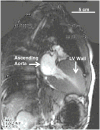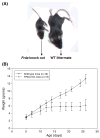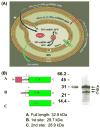Cardiomyopathy of Friedreich's ataxia: use of mouse models to understand human disease and guide therapeutic development
- PMID: 21360265
- PMCID: PMC3097037
- DOI: 10.1007/s00246-011-9943-6
Cardiomyopathy of Friedreich's ataxia: use of mouse models to understand human disease and guide therapeutic development
Abstract
Friedreich's ataxia is a multisystem disorder of mitochondrial function affecting primarily the heart and brain. Patients experience a severe cardiomyopathy that can progress to heart failure and death. Although the gene defect is known, the precise function of the deficient mitochondrial protein, frataxin, is not known and limits therapeutic development. Animal models have been valuable for understanding the basic events of this disease. A significant need exists to focus greater attention on the heart disease in Friedreich's ataxia, to understand its long-term outcome, and to develop new therapeutic strategies using existing medications and approaches. This review discusses some key features of the cardiomyopathy in Friedreich's ataxia and potential therapeutic developments.
Figures












Similar articles
-
Cardiomyopathy of Friedreich ataxia.J Neurochem. 2013 Aug;126 Suppl 1:88-93. doi: 10.1111/jnc.12217. J Neurochem. 2013. PMID: 23859344 Review.
-
The GAA repeat expansion in intron 1 of the frataxin gene is related to the severity of cardiac manifestation in patients with Friedreich's ataxia.J Mol Med (Berl). 2001;78(11):626-32. doi: 10.1007/s001090000162. J Mol Med (Berl). 2001. PMID: 11269509
-
Prevention and reversal of severe mitochondrial cardiomyopathy by gene therapy in a mouse model of Friedreich's ataxia.Nat Med. 2014 May;20(5):542-7. doi: 10.1038/nm.3510. Epub 2014 Apr 6. Nat Med. 2014. PMID: 24705334
-
Friedreich's ataxia.Pediatr Neurol. 2003 May;28(5):335-41. doi: 10.1016/s0887-8994(03)00004-3. Pediatr Neurol. 2003. PMID: 12878293 Review.
-
[Heart involvement in Friedreich's ataxia].Herz. 2015 Mar;40 Suppl 1:85-90. doi: 10.1007/s00059-014-4097-y. Epub 2014 May 23. Herz. 2015. PMID: 24848865 Review. German.
Cited by
-
Friedreich ataxia: neuropathology revised.J Neuropathol Exp Neurol. 2013 Feb;72(2):78-90. doi: 10.1097/NEN.0b013e31827e5762. J Neuropathol Exp Neurol. 2013. PMID: 23334592 Free PMC article. Review.
-
Neuro-Cardio Mechanisms in Huntington's Disease and Other Neurodegenerative Disorders.Front Physiol. 2018 May 23;9:559. doi: 10.3389/fphys.2018.00559. eCollection 2018. Front Physiol. 2018. PMID: 29875678 Free PMC article. Review.
-
Cardiomyopathy of Friedreich's ataxia (FRDA).Ir J Med Sci. 2012 Dec;181(4):569-70. doi: 10.1007/s11845-012-0808-7. Epub 2012 Feb 29. Ir J Med Sci. 2012. PMID: 22373590 No abstract available.
-
Hyperactivation of mTOR and AKT in a cardiac hypertrophy animal model of Friedreich ataxia.Heliyon. 2022 Aug 23;8(8):e10371. doi: 10.1016/j.heliyon.2022.e10371. eCollection 2022 Aug. Heliyon. 2022. PMID: 36061025 Free PMC article.
-
Iron-sulfur cluster synthesis, iron homeostasis and oxidative stress in Friedreich ataxia.Mol Cell Neurosci. 2013 Jul;55:50-61. doi: 10.1016/j.mcn.2012.08.003. Epub 2012 Aug 11. Mol Cell Neurosci. 2013. PMID: 22917739 Free PMC article. Review.
References
-
- Alboliras ET, Shub C, Gomez MR, Edwards WD, Hagler DJ, Reeder GS, Seward JB, Tajik AJ. Spectrum of cardiac involvement in Friedreich’s ataxia: clinical, electrocardiographic, and echocardiographic observations. Am J Cardiol. 1986;58:518–524. - PubMed
-
- Al-Mahdawi S, Pinto RM, Ismail O, Varshney D, Lymperi S, Sandi C, Trabzuni D, Pook M. The Friedreich ataxia GAA repeat expansion mutation induces comparable epigenetic changes in human and transgenic mouse brain and heart tissues. Hum Mol Genet. 2008;17:735–746. - PubMed
-
- Begley DJ. The blood–brain barrier: principles for targeting peptides and drugs to the central nervous system. J Pharm Pharmacol. 1996;48:136–146. - PubMed
-
- Boddaert N, Le Quan Sang KH, Rotig A, Leroy-Willig A, Gallet S, Brunelle F, Sidi D, Thalabard JC, Munnich A, Cabantchik ZI. Selective iron chelation in Friedreich ataxia: biologic and clinical implications. Blood. 2007;110:401–408. - PubMed
-
- Brautigam CA, Chuang JL, Tomchick DR, Machius M, Chuang DT. Crystal structure of human dihydrolipoamide dehydrogenase: NAD+/NADH binding and the structural basis of disease-causing mutations. J Mol Biol. 2005;350:543–552. - PubMed
Publication types
MeSH terms
Substances
Grants and funding
LinkOut - more resources
Full Text Sources
Other Literature Sources
Medical

